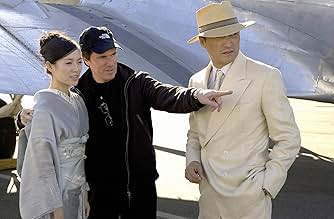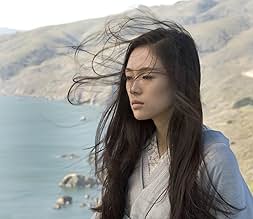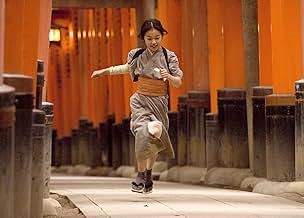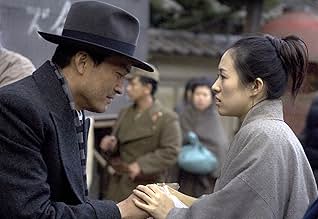Nitta Sayuri revela cómo trascendió sus raíces de aldea de pescadores y se convirtió en una de las geishas más famosas de Japón.Nitta Sayuri revela cómo trascendió sus raíces de aldea de pescadores y se convirtió en una de las geishas más famosas de Japón.Nitta Sayuri revela cómo trascendió sus raíces de aldea de pescadores y se convirtió en una de las geishas más famosas de Japón.
- Ganó 3 premios Óscar
- 32 premios ganados y 47 nominaciones en total
- Dirección
- Guionistas
- Todo el elenco y el equipo
- Producción, taquilla y más en IMDbPro
Opiniones destacadas
Lavish cinematography means 'Memoirs of a Geisha' is never anything less than visually beautiful, and it's hard to think of how any other movie could beat it to an Oscar in this department come March next year. However, the true merit of the film lies in the fact that its sumptuous style does not outweigh substance, something particularly thankful given that such an imbalance was so unfortunately true of House of Flying Daggers, the last major release to star Ziyi Zhang. Instead, the truly enchanting performance of 12-year old Suzaka Oghu, who plays the young Sayuri for the first half hour, ensures attention is captured within her character's story for the rest of the drama. This allows the script to remain pleasingly understated, and also means the unlikely nature of the romance can be overlooked.
The hibernation that the story withdraws into during the wartime years could so easily have been damaging, but in the event the portrayal of how the post-war influx of American troops corrupted Japan's ancient traditions is just as excellent as the rest of the film.
The hibernation that the story withdraws into during the wartime years could so easily have been damaging, but in the event the portrayal of how the post-war influx of American troops corrupted Japan's ancient traditions is just as excellent as the rest of the film.
In Japan of the 20's, the nine years old Chyio (Suzuka Ohgo) and her sister Satsu (Samantha Futerman) are sold by her fisherman father to a Geisha house in Miyako. Satsu is not accepted in the house and is sent to a brothel, and along the years, Satsu escapes from he brothel where she lived and the rebel Chyio is left alone, becoming a slave of a geisha. However, six years later, she learns how to become the geisha Sayuri (Ziyi Zhang) with the support of the successful Mameha (Michelle Yeoh), while fighting against the evil and jealousy of the wicked Hatsumomo (Gong Li). While still a child, Chyio falls in love with The Chairman (Ken Watanabe), and in the post-WWII, they meet each other, in a period o changes in Japan with the occupying American forces and the country completely destroyed.
The first half of "Memoirs of a Geisha" is a beautiful drama, telling the story of the country girl Chyio alone and adapting to a new life style in a house of geisha. Then, in the end of World War II, the screenplay becomes a soap-opera and the story becomes lesser and lesser attractive. However, the cinematography, the art direction and the costume design are amazing along the whole movie. But the cast speaking in English and keeping some Japanese words seems quite ridiculous for me. For such a careful production, this seems to be an unforgivable mistake. My vote is eight.
Title (Brazil): "Memórias de uma Gueixa" ("Memoirs of a Geisha")
The first half of "Memoirs of a Geisha" is a beautiful drama, telling the story of the country girl Chyio alone and adapting to a new life style in a house of geisha. Then, in the end of World War II, the screenplay becomes a soap-opera and the story becomes lesser and lesser attractive. However, the cinematography, the art direction and the costume design are amazing along the whole movie. But the cast speaking in English and keeping some Japanese words seems quite ridiculous for me. For such a careful production, this seems to be an unforgivable mistake. My vote is eight.
Title (Brazil): "Memórias de uma Gueixa" ("Memoirs of a Geisha")
Going into the film, I had worries with all the slamming critics have given, even though I didn't read all of them in details. However, I'm happy to say it turns out to be one of more satisfying movie experiences of the year.
First I echo the sentiment that the film is simply technically perfect. The retro-mood it created had me immensed in the world of geisha from beginning to the end. It's very 1930 Shanghai like. The music score isn't as haunting as the one in CTHD, but it is still masterfully composed and fits in the background very well. It's worth seeing for the big screen experience alone. The story also never dragged, as each of the three parts flowed nicely. I normally don't like voice-over, but here it really held the movie together and helped to move the story along.
As for the accents, the problem has definitely been exaggerated. I was expecting a lot of unpleasant broken English to be spoken, but they all sounded fine to good, not just from the most fluent Michelle Yeoh, but Ken Watanabe, Youki Kudoh (who plays Pumpkin) and other supporting casts. Gong Li had a few awkward lines at the beginning, and Ziyi had more and is the one who had to try the hardest, but both pulled off admirably and didn't hurt their performances in the process.
Talking about performances, I think almost all of them did well. It's much more of an ensemble piece, and I was especially impressed by the young Sayuri and Ken Watanabe.
The main problem I have is with character development. It is a Cinderella story at heart, but the good and evil are too clear-cut and lack dimension. I also want to see more ups and downs for the competition between Ziyi and Gong Li. Gong did all she could, but the script didn't allow her to be a worthy opponent. Except for some verbal back-and-forth between the two and a few dirty tricks from Gong, there was no reason to believe why she was the most famous geisha in Japan before Ziyi arrived.
In addition, the Mother character is over-the-top and didn't fit the emotional aspect the film quite well, although she did provide some comical moments. The big dance scene had excellent buildup, but the execution of the dance felt flat. It lasted only about 30 seconds, while doubling that and making it more mesmerizing would have made the whole middle act more effective.
These flaws didn't overshadow the fact that what was put on screen worked for me. Will I be willing to watch it again with friends? In a heartbeat. Will I recommend it to others? Definitely. With that in mind, I give the film an A-.
First I echo the sentiment that the film is simply technically perfect. The retro-mood it created had me immensed in the world of geisha from beginning to the end. It's very 1930 Shanghai like. The music score isn't as haunting as the one in CTHD, but it is still masterfully composed and fits in the background very well. It's worth seeing for the big screen experience alone. The story also never dragged, as each of the three parts flowed nicely. I normally don't like voice-over, but here it really held the movie together and helped to move the story along.
As for the accents, the problem has definitely been exaggerated. I was expecting a lot of unpleasant broken English to be spoken, but they all sounded fine to good, not just from the most fluent Michelle Yeoh, but Ken Watanabe, Youki Kudoh (who plays Pumpkin) and other supporting casts. Gong Li had a few awkward lines at the beginning, and Ziyi had more and is the one who had to try the hardest, but both pulled off admirably and didn't hurt their performances in the process.
Talking about performances, I think almost all of them did well. It's much more of an ensemble piece, and I was especially impressed by the young Sayuri and Ken Watanabe.
The main problem I have is with character development. It is a Cinderella story at heart, but the good and evil are too clear-cut and lack dimension. I also want to see more ups and downs for the competition between Ziyi and Gong Li. Gong did all she could, but the script didn't allow her to be a worthy opponent. Except for some verbal back-and-forth between the two and a few dirty tricks from Gong, there was no reason to believe why she was the most famous geisha in Japan before Ziyi arrived.
In addition, the Mother character is over-the-top and didn't fit the emotional aspect the film quite well, although she did provide some comical moments. The big dance scene had excellent buildup, but the execution of the dance felt flat. It lasted only about 30 seconds, while doubling that and making it more mesmerizing would have made the whole middle act more effective.
These flaws didn't overshadow the fact that what was put on screen worked for me. Will I be willing to watch it again with friends? In a heartbeat. Will I recommend it to others? Definitely. With that in mind, I give the film an A-.
Marshall's adaptation of Golden's 'Memoirs of a Geisha' appears to be concise and a little tepid. It leaves out some crucial parts of the novel. Moreover, the characters in the novel are very well developed. The movie somehow fails to show this. I can understand that there were time constraints and the movie is already longer than the usual 2 hours but some important sequences, like the love story between the Chairman and Sayuri needed more development. As a director, Marshall does not do a bad job at all. He's the one who gives the film an enchanting feeling. With the spectacular visuals he presents a lot of subtle symbolism. Actually, what really makes 'Memoirs of a Geisha' watchable is that it's fascinating to look at. The dazzling colourful visuals and mesmerizing soundtrack are incredible. The shots of the landscape, the costumes, the choreography and the spectacular cinematography are breathtaking.
I wonder why three Chinese actresses were cast in the main roles? I can understand why this would upset some Japanese people. My Japanese friend joked that it was perhaps because Japanese actresses don't speak good English. Though, the most likely reason for Ziyi, Yeoh and Li's casting may be their international appeal (as they are quite well known throughout the world) and that Li and Yeoh are also accomplished actresses while Ziyi is kind of a star.
Among the performances, it is the supporting cast who stand out. Zhang Ziyi lacks the liveliness and curiosity of Sayuri. Ziyi seems to be too conscious of the fact that she's only acting. Even child actress Suzuka Ohgo, who plays young Sayuri, does a better job. Youki Kudoh gets more scope to perform near the end and does a decent job. Gong Li is superb as the wicked fiery Hatsumomo (but, sadly, her character is one-dimensional) and an enigmatic Michelle Yeoh is equally outstanding as the once divine geisha Mameha. Among the men, it is Kôji Yakusho who impresses as the brave but stubborn Nobu. Ken Watanabe is alright.
To sum it up, I loved watching 'Memoirs of a Geisha' mainly because it was very pleasing to the eyes. Marshall has handled plenty of sequences beautifully but it lacks a stronger heart (perhaps this is due to miscasting Zhang Ziyi). Having read the book, I'm not that disappointed as, even though some parts have been left out, not too much has been altered. Thus, it tries to stay true to the book. I think it also introduces the beauty of the ancient Japanese culture quite sensibly. Whether that feels real to some is another point.
I wonder why three Chinese actresses were cast in the main roles? I can understand why this would upset some Japanese people. My Japanese friend joked that it was perhaps because Japanese actresses don't speak good English. Though, the most likely reason for Ziyi, Yeoh and Li's casting may be their international appeal (as they are quite well known throughout the world) and that Li and Yeoh are also accomplished actresses while Ziyi is kind of a star.
Among the performances, it is the supporting cast who stand out. Zhang Ziyi lacks the liveliness and curiosity of Sayuri. Ziyi seems to be too conscious of the fact that she's only acting. Even child actress Suzuka Ohgo, who plays young Sayuri, does a better job. Youki Kudoh gets more scope to perform near the end and does a decent job. Gong Li is superb as the wicked fiery Hatsumomo (but, sadly, her character is one-dimensional) and an enigmatic Michelle Yeoh is equally outstanding as the once divine geisha Mameha. Among the men, it is Kôji Yakusho who impresses as the brave but stubborn Nobu. Ken Watanabe is alright.
To sum it up, I loved watching 'Memoirs of a Geisha' mainly because it was very pleasing to the eyes. Marshall has handled plenty of sequences beautifully but it lacks a stronger heart (perhaps this is due to miscasting Zhang Ziyi). Having read the book, I'm not that disappointed as, even though some parts have been left out, not too much has been altered. Thus, it tries to stay true to the book. I think it also introduces the beauty of the ancient Japanese culture quite sensibly. Whether that feels real to some is another point.
Can a group of American men and Chinese actresses render the world of a Japanese geisha? The answer is yes, with stunning beauty
and regrettable flaws.
Truth be told, this movie was not as bad as its trailer led me to expect it to be. It had a story to tell (although it crumbles in the end),images to show, and material to present. There were ample displays of exquisite beauty -- the trailing tails of silk kimonos, the subtle allure of hand gestures, and the captivating scene of kabuki dance theater ...
On the other hand, the American director was not able to pull the Japanese out of Chinese actresses. (This movie was so crowded by famous Chinese idols that I found myself inadvertently searching for Joan Chen among the cast.) To be fair, all three main actors (Gong Li in particular) show strong performances that made me sympathetic to Rob Marshall's choices. However, they remain utterly Chinese throughout this movie. The look and accent are not the only problems. They lacked the kind of extreme femininity and excessive felicity of the delicately mechanical gesture and movements of traditional Japanese ladies you see in custom dramas of Japanese production. (Michelle Yeoh seems to be the only one trying a little bit of those, but it did not quite work for some reason.)
So, let me re-address the question: Can a group of American men and Chinese actresses render the world of a geisha? The answer, I guess, really depends on what you are looking for. If you would like a little bit of delight from an aesthetically pleasing picture with a dubious authenticity and realism, this movie delivers it. I would not say Rob Marshall failed completely. Memoirs of a Geisha is not the first, nor the last, movie that subjects another culture to the crude lens of American exoticism. It definitely is not the worst one.
Truth be told, this movie was not as bad as its trailer led me to expect it to be. It had a story to tell (although it crumbles in the end),images to show, and material to present. There were ample displays of exquisite beauty -- the trailing tails of silk kimonos, the subtle allure of hand gestures, and the captivating scene of kabuki dance theater ...
On the other hand, the American director was not able to pull the Japanese out of Chinese actresses. (This movie was so crowded by famous Chinese idols that I found myself inadvertently searching for Joan Chen among the cast.) To be fair, all three main actors (Gong Li in particular) show strong performances that made me sympathetic to Rob Marshall's choices. However, they remain utterly Chinese throughout this movie. The look and accent are not the only problems. They lacked the kind of extreme femininity and excessive felicity of the delicately mechanical gesture and movements of traditional Japanese ladies you see in custom dramas of Japanese production. (Michelle Yeoh seems to be the only one trying a little bit of those, but it did not quite work for some reason.)
So, let me re-address the question: Can a group of American men and Chinese actresses render the world of a geisha? The answer, I guess, really depends on what you are looking for. If you would like a little bit of delight from an aesthetically pleasing picture with a dubious authenticity and realism, this movie delivers it. I would not say Rob Marshall failed completely. Memoirs of a Geisha is not the first, nor the last, movie that subjects another culture to the crude lens of American exoticism. It definitely is not the worst one.
¿Sabías que…?
- TriviaThe elements of nature are a running theme through this film and each of the four main Geisha have an elemental character. Sayuri is water, Mameha is wind, Pumpkin is wood (the equivalent of earth) and Hatsumomo is fire.
- ErroresWhen Hatsumomo and Pumpkin are leaving on the night of Pumpkin's debut, neither Mother nor Auntie spark flint on their backs. A Geisha would never leave her okiya without this act being performed as it was believed it brought good luck.
- Créditos curiososNo studio logos are shown at the beginning; they appear shortened after the end credits and are accompanied by the film's score.
- ConexionesFeatured in The 63rd Annual Golden Globe Awards 2006 (2006)
- Bandas sonorasAnata No Mono Yo
Written by Takao Saeki and Kôka Sassa
Performed by Noriko Awaya
Courtesy of Columbia Music Entertainment, Inc.
Selecciones populares
Inicia sesión para calificar y agrega a la lista de videos para obtener recomendaciones personalizadas
- How long is Memoirs of a Geisha?Con tecnología de Alexa
- Is 'Memoirs of a Geisha' based on a book?
- What was the significance of the handkerchief?
- What was the white stuff that the geishas had to sleep on?
Detalles
- Fecha de lanzamiento
- País de origen
- Sitio oficial
- Idiomas
- También se conoce como
- Memoirs of a Geisha
- Locaciones de filmación
- California State Railroad Museum - 111 I Street, Sacramento, California, Estados Unidos(interiors: railroad station)
- Productoras
- Ver más créditos de la compañía en IMDbPro
Taquilla
- Presupuesto
- USD 85,000,000 (estimado)
- Total en EE. UU. y Canadá
- USD 57,490,508
- Fin de semana de estreno en EE. UU. y Canadá
- USD 682,504
- 11 dic 2005
- Total a nivel mundial
- USD 162,242,962
- Tiempo de ejecución2 horas 25 minutos
- Color
- Mezcla de sonido
- Relación de aspecto
- 2.39 : 1
Contribuir a esta página
Sugiere una edición o agrega el contenido que falta








































